Canon Digital Rebel XT: Hardly an Entry-Level DSLR
by Stephen Caston on May 3, 2005 12:05 AM EST- Posted in
- Digital Camera
The Design: Canon EOS 350D
The Canon EOS 350D looks remarkably different than its predecessor, the 300D. In fact, it is so different from the 300D that it makes more sense to compare it to its older and more expensive brother, the Canon 20D. Both cameras have similar sensors, although the sensor in the 350D is slightly smaller. The 20D sensor is 8.2 megapixels and 22.5 mm x 15.0 mm while the 350D sensor is 8.0 megapixels and 22.2 mm x 14.8 mm. The 350D is the smallest digital SLR available from Canon, measuring just 126.5 mm x 94.2 mm x 64 mm. Some other similarities between the 350D and 20D are Canon's DIGIC II image processor, which makes for speedy image processing. Both cameras have remarkable startup times (nearly instantaneous) and incredibly fast transfer speeds from the internal buffer to flash media. Also, both cameras feature an EF-S lens mount that will accept all EF lenses as well as the newer EF-S lenses designed specifically for cameras with a 1.6x crop factor. Perhaps due to popular demand, Canon has implemented 9 Custom Functions into the 350D, which allow the user more extensive control over the camera's operations.On the front of the 350D, we can see the EF-S lens mount that accepts EF as well as EF-S lenses. In the image above, the 350D is shown with the "kit lens", which is an EF-S 18-55mm f/3.5-5.6. The camera can be purchased with this kit lens or separately. On the right side of the front, we can see the lens release button. By pressing this button while rotating the lens, the lens can be detached from the lens mount. On the left side is a circular lamp that acts as the red-eye reduction/self-timer light. It may be hard to see from this angle, but the hand grip on the left side is considerably smaller than it was on the 300D. We will discuss this more in a bit.
As the picture above illustrates, the built-in flash on the 350D rises to a remarkable height. In fact, it is just a bit higher than the flash on the 300D. This should help when attempting to shoot with the flash while using a long lens and/or lens hood.
The layout of the back of the 350D is very similar to the 300D. At the top is the viewfinder that is surrounded in rubber. To the upper-right of the viewfinder is a diopter adjustment knob, which can alter the focus of the viewfinder. Directly below the lens are the LCD panel and 1.8" LCD monitor with 115K pixels. Along the left side are 5 function buttons: Menu, Info., Jump, Play, and Erase. At the upper-right corner of the back are the AE lock/FE lock/Reduce and AF point selection/Enlarge buttons. On the right side of the LCD panel are the Aperture/Exposure compensation button and the Drive mode selection button. On the 300D, the Drive mode selection button was on top of the camera. Below this is the Direct print/LCD panel illumination button. Pressing this button will illuminate the LCD panel with orange light for approximately 6 seconds or until the button is pressed again. To the right of the LCD monitor are the 4-way cross keys with a Set button in the middle. Each arrow button also corresponds to a recording function that can be accessed whenever the camera is on. When a function is selected, the corresponding options screen will appear on the LCD monitor. This is different from the original Rebel (300D) where these options would be selected on the LCD information panel instead. Below are the associated functions:
| Up | ISO |
| Right | Auto Focus |
| Down | White Balance |
| Left | Metering |
To the lower-left of the cross keys is the access lamp, which lights up whenever the camera is reading or writing to removable media.
Starting at the left, we can see the first post for the included neck strap. Directly above the lens is the flash hot-shoe, which accepts Canon's EX-series Speedlite as well as third party flashes. The 350D features Canon's new E-TTL II flash system that is supposed to produce better automatic flash exposures. To the right of the flash hot-shoe is the Mode dial where you can select from 12 different shooting modes. Just like the 300D, the main power switch is located on the right side of the Mode dial. On the top of the hand grip are the Main Dial and shutter button. Finally, the other post for the neck strap is just beside the main power switch. It is a little easier to see the size of the handgrip in this image. Since the camera is relatively thin, you can see that there is not a lot of depth in the handgrip in which to put your fingers. This may be a problem for people with longer fingers or bigger hands.
 |
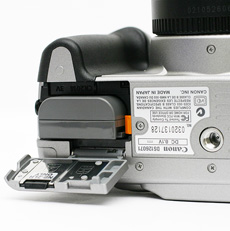 |
| Click to enlarge images. | |
On the bottom of the 350D is the door that conceals the battery compartment. The door can be opened by pressing the release lever. The battery is also secured by an orange clip that must be pushed to the side to release the battery. The 350D uses an NB-2LH Lithium-Ion battery (7.4V 720 mAh) as opposed to the BP-511A used in the 300D. The NB-2LH is physically smaller and has a smaller capacity (65%) than that of the BP-511A. In fact, the NB-2LH is the same battery type used in the Canon PowerShot S60 and S70. Directly below, the lens is the metal tripod mount.
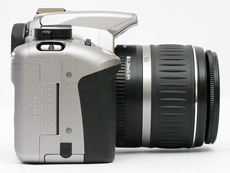 |
 |
| Click to enlarge images. | |
On the right side of the camera is a sliding hinged door that conceals the Compact Flash (Type I or II)/Microdrive media slot. Because it supports FAT32, the 350D supports removable media over 2GB.
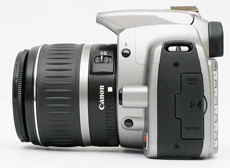 |
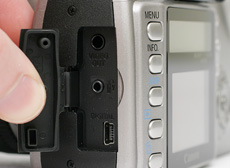 |
| Click to enlarge images. | |
At the upper left is the Flash button. In order to release the flash in any of the advanced recording modes, this button must be pressed. Just below the lens release button is the DOF (depth-of-field) preview button. Normally, when framing an image, the camera will use the largest available aperture to ensure that the photographer can see clearly. By holding down the DOF preview button, the camera will close the aperture (stop down) to the selected value. This gives the photographer an idea of how the image will actually look with the correct DOF. The left side of the camera features 3 connections that are concealed by a rubber fitted tab. The top connection is a video-out port that can be used with the included video cable to view images on a television. The middle port is a remote control terminal that will work with the Remote Switch RS-60E3. Finally, the bottom connection is a USB 2.0 Hi-Speed port.


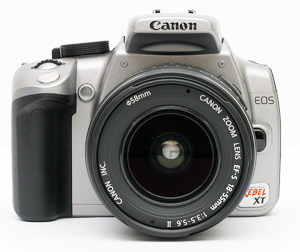
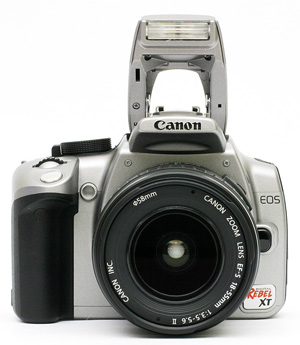
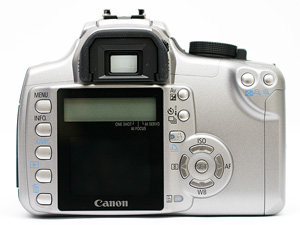
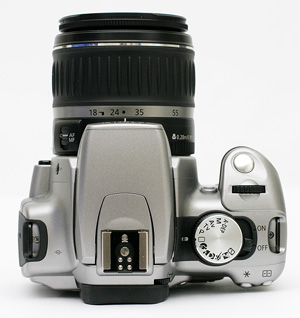








27 Comments
View All Comments
DVad3r - Tuesday, May 3, 2005 - link
Hmm possibly, what page is the blurb on?STaSh - Tuesday, May 3, 2005 - link
That's probably the sensor that tracks if the camera is vertical or horizontal. It's used to determine how you want a vertical image to be displayed on the LCD.There should be a blurb in the manual about it.
DVad3r - Tuesday, May 3, 2005 - link
I have a question to XT owners. I have noticed last night when holding my camera, that there seems to be something loose inside. I was just moving it up and down in my hands trying out different angles when I noticed what seems like something is moving around inside. The camera was brand new when I got it, and packed very nicely, and certainly has not been dropped or exposed to any shock at all. I was wondering if you guys have it too?Rebel II - Thursday, August 25, 2005 - link
I agree about the noise, there seems to be something loose in the camera. Mine is brand new and has not been subjected to any shock. I've been practicing using it and never noticed anything for the first six days. It is very quiet at times when I am practicing but I have never noticed a sound until the sixth night. I was using a "long exposer time" and after that I noticed a sound everytime I tilted the camera back and forth. I can even feel it as I move it. Everything seems to work the same. I can't figure out why I didn't notice it before. I was ready to return it but decided to check on the web to see what others have experienced. You are the second person to mention this so far as I have just began my search.Possessed Freak - Tuesday, May 3, 2005 - link
Hrmmm, I may actually have to try one of these out. I still use my Canon AE-1 program for all my picture taking. This DSLR really has me intrigued.NFS4 - Tuesday, May 3, 2005 - link
Stephen, I got my D70 Kit a few weeks ago from OneCall.com for $899.99 after a $100 Nikon rebate.Also don't forget the Nikon D50, which I hope you will be reviewing soon along with the Nikon D70S
Xtremist - Tuesday, May 3, 2005 - link
Anyone want to buy the original Rebel? ;-) Man, I WANT one of these lol!roibm - Tuesday, May 3, 2005 - link
glad it's fixed... I freaked out seeing it didn't work with my default browser(opera) and then not even with firefox.I can confirm it works with both as well.
stephencaston - Tuesday, May 3, 2005 - link
#6, the javascript problem has been fixed. It now works fine in Firefox, Opera, etc...#7, yes the Rebel XT shoots at 72 dpi
rootaxs - Tuesday, May 3, 2005 - link
Thanks for the review, would you mind posting though if the processed photo's that come out of the XT are at 300dpi or 72dpi? (e.g. at max resolution, not resized to become a 300dpi image).